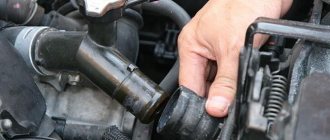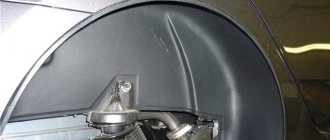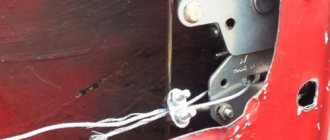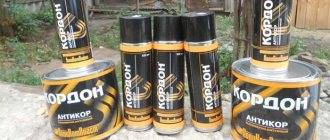Sign up for the service
We present to you – an electric engine heater with a circulation pump “Severs+” !
Throughout its history, it has maintained leadership in quality, new technologies and production volumes. It was Leader that was the first in Russia to begin producing electric engine heaters. And now we are proud to present the first Russian heater with a circulation pump.
All generations of Severs internal combustion engine heaters have proven themselves well and have earned the trust of motorists throughout Russia and the CIS. The same tradition of high quality and multi-level control in production is adopted by Severs+ .
Pre-heaters Severs+ in Tomsk:
- Severs+ 2 kW — 3,800 rub. (retail price) Price with installation (2 kW) from 6,800 rub. (depending on the car)
- Severs+ 2 kW (with bumper connector) — 4,200 rub. (retail price) Price with installation (2 kW) from 7,700 rub. (depending on the car)
- Severs+ 3 kW — 4,300 rub. (retail price) Price with installation (3 kW) from 7,300 rub. (depending on the car)
What is the main difference from Severs-M?
“Severs+” is a new generation heater. It warms up the engine faster and more evenly than heaters without a pump, under equal conditions!
FAST HEATING UP “Severs+” is equipped with a circulation pump and a powerful heating element. Due to this, the engine warms up much faster. The recommended warm-up time is only about 30 minutes.
INSTALLATION - EASIER! You no longer need to look strictly for the lowest point to install the heater! The coolant circulates not due to temperature differences, but thanks to the pump built into the Severs+. One installation diagram for all car models and engine types, regardless of the location of the thermostat. The heater is installed in the section of the coolant supply hose from the engine to the interior heater radiator.
UNIVERSAL INSTALLATION KIT Suitable for all cars and immediately included in the box with the heater. No need to buy separately!
UNIFORMITY OF HEATING Thanks to constant circulation in the “small” circle of the cooling system, all the liquid is heated evenly. This means that all engine parts will warm up smoothly.
DOUBLE OVERHEAT PROTECTION AND INCREASED ELECTRICAL SAFETY Just like the legendary Severs-M model, the new Severs+ heater is equipped with a thermostat and additional protection against overheating - a thermal switch.
LONG WARRANTY 2 YEARS We are responsible for quality and therefore we give such a long guarantee.
The “Severs+” model of a pre-start electric engine heater with a forced circulation pump (pump) has a power of 2 kW or 3 kW and operates from a 220 V electrical network. It can be ordered through the online order form or purchased from official dealers.
Technical data "Severs+"
- Power "Severs+": 2.0 kW
- Powered by mains power, rated voltage: 220V
- Type of current: alternating
- Current frequency: 50Hz
- Anodized aluminum housing
- Thermostat (operation temperature 90°C (not lower)
- Thermal switch (operation temperature 140°C (not higher)
Sealed housing design with an electric heating element, completely eliminating the penetration of coolant into the electrical part.
The design of the Severs+ heater liquid pump (pump) eliminates the possibility of coolant leakage on rubbing surfaces, as it uses a magnetic type rotor (similar to the popular BOSСH pumps). The pump impeller has no seals and is located in a completely sealed housing. The product is certified and tested.
How Severs+ works
Severs+ is built into the car's cooling system. When connected to a 220V network, the heating element in the heater body begins to heat up. At the same time, the circulation pump comes into operation, pumping the heated liquid through the cooling system. Cold coolant enters the top pipe and exits through the bottom.
When the required temperature is reached, the thermostat is activated. It turns off both the heating element and the pump. When the temperature of the coolant decreases, the thermostat will turn on heating and circulation again, thus constantly maintaining the coolant temperature in the specified range.
After about 30 minutes of Severs+ operation, the coolant in the system is warmed up to a temperature of about +70 C, and the car is ready for use.
The engine warm-up time depends on climatic conditions (temperature, wind), as well as on the parking conditions of the car (open parking, garage).
Severs+ is equipped with a universal installation kit. It includes all the necessary parts and detailed installation instructions.
Attention! Installed VERTICALLY, according to the instructions!
If possible, we recommend installing Severs+ with a service center. However, following the recommendations and observing the instructions, you can install the heater yourself. As practice shows, installation takes 2-4 hours.
Heaters Severs M
The heater is available in three modifications:
Severs-M1
(1.5 kW) - for passenger cars with an engine capacity of more than 1.5 liters, as well as for Gazelle class cars
- Severs-M2
(2 kW) - for medium-duty vehicles - Severs-M3
(2 and 3 kW) - for heavy vehicles
Heater device
Horizontal design eliminates the possibility of antifreeze (coolant) getting into the electrical part of the heater, which makes its operation safer.
Ball valve - ensures directed circulation of elevated fluid temperature through the heater into the engine cooling system.
Thermostat - ensures optimal engine warm-up, does not allow the heater to heat above the set temperature, which protects the device from overheating and saves energy.
Thermal switch - protects the heater in case of abnormal operation (insufficient amount of coolant or lack thereof), in case of failure (failure) of the thermostat.
Main technical characteristics and design features
- Power 1.5, 2.0, 3.0 kW
- Rated voltage 220V
- Type of current – alternating
- Current frequency 50 Hz
- Anodized aluminum housing
- Hermetically sealed housing design with an electric heating element completely eliminates the ingress of coolant into the electrical part
- Thermostat (operation temperature 90°C (not lower)
- Thermal switch (operation temperature 140°C (not higher)
- Small dimensions allow convenient placement of the heater in the engine compartment
To facilitate the process of installing heaters, special installation kits (sets of fittings, clamps, hoses, sleeves, etc.) have been developed for almost every car.
Sewers mounting kit
VAZ No. 1 VAZ-2101…-2107 with carb. dv. No. 2 VAZ-2123 with engine. VAZ, Niva with engineer. or carb. dv. No. 3 VAZ-2170 “Priora”, VAZ-2108, -2109 with carb. doors, VAZ-2110…-2112 with 16 cells. Eng. or carb. dv. No. 4 VAZ-2108…-2115 with 8 cells. Eng. dv. No. 11 VAZ-2104, -2105, -2107 with engineer. dv. No. 12 VAZ-1117…-1119 “Kalina” with 8 cells. dv. No. 32 VAZ-2190 “Granta” with 8 classes of engineering doors.
UAZ No. 7 UAZ (passenger cars) with carb. dv. UMP No. 19 UAZ “Hunter” with doors. ZMZ-4091 No. 24 UAZ (passenger cars) with dv. 51430E No. 26 UAZ (truck) with engineer. dv. 42130N No. 29 UAZ “Patriot” with dv. IVECO F1A No. 33 UAZ “Patriot” with engine. ZMZ 409.10 from 2011 No. 34 UAZ (Cargo-passenger) with doors. ZMZ-4091
GAZ No. 5 GAZ “Volga”, “Gazelle” with engine. 402 No. 6 GAZ “Gazelle”, “Sable” with engine. 405, 406 No. 16 GAZ-31105 "Volga" with engine. DCC 2.4L DOHC Daimler Chysler No. 18 GAZ "Volga" with engine. 406 No. 28 GAZ “Gazelle”, “Sable” with d. 405, 406 EURO 3 No. 30 GAZ "Gazelle" with dv. UMZ 42160 No. 31 GAZ "Gazelle" with engine. ISE2.8S3129T (Cummins) No. 50 GAZ-3309 with engine. MMZ-D245.7E2 No. 51 GAZ-3310 “Valdai” with engine. MMZ-D245.7E2 No. 60 GAZ, KAvZ, PAZ with engine. 511, 513, 523 No. 62 GAZ-33106 “Valdai” with ISF3.8S3154 engine (Cummins) 2010.
ZIL No. 52 ZIL “Bull” with door. MMZ-D245.12 No. 61 ZIL with dv. 508.10 MAZ, KAMAZ No. 70 MAZ with engine. YaMZ-7511.10-27 (E2), YaMZ-238DE2 No. 71 KAMAZ No. 72 MAZ with engine. YaMZ-236
URAL
No. 73 URAL with engine YaMZ-236HE2 (Euro-2) FOREIGN CAR No. 74 MAN TGA 18.390 with engine. D2066LF02 No. 75 Mercedes-Benz AXOR 1840LS 4×2 with dv. OM457LA (Euro-3) No. 76 Freightliner Colambia 120 with dv. Detroit Diesel 6067HV6E No. 77 Mercedes-Benz ACTROS 1840LS, with engine. OM501LAIII/5 No. 120 Toyota Corolla 2007, door. 1ZR (1.6 l), manual transmission No. 201 Nissan Almera 2006, d. QG16 (1.6 l.), manual transmission No. 205 Nissan X-Trail 2008, d. QR25 (2.5 l), automatic transmission No. 209 Nissan Note 2007, d. HR (1.6 l), manual transmission No. 210 Nissan Qashqai with d. HR16DE (1.6 l) No. 301 Chevrolet Aveo 2004, d. F14D3, F14S3 (1.4l), manual transmission; Lacetti 2005, door F14D3 (1.4l), F16D3 (1.6l), manual transmission; Lanos 2007, door A15SMS (1.5 l), manual transmission No. 302 Chevrolet Cruze 2010, d. F16D3 (1.6 l), manual transmission No. 303 Chevrolet Spark 2011, d. B10D1 (1.0 l) No. 304 Chevrolet Aveo 2012, d. 1.6 l, automatic transmission No. 501 Ford Focus 2003, d. CDDA (1.6 l), manual transmission No. 502 Ford Focus 2007, d. QQDB (1.8 l), manual transmission; Focus 2007, door HXDB (1.6 l), manual transmission; Focus 2007, door SHDA (1.6 l), automatic transmission; Fusion 2007, d. FXSA (1.4 l), manual transmission; Ford Focus 3, 2011 onwards, with IQDB engine (1.6 l), manual transmission No. 506 Ford S-Max 2008 onwards, with engine SEWA (2.3 l), automatic transmission No. 508 Ford Transit 2008, d. JXFA (2.4 l) No. 509 Ford Ranger 2008, d. 2.5 DT (2.4 l.) No. 602 Hyundai Getz 2002, KIA Rio with G4EE engine (1.4 l), manual transmission; Hyundai Accent door G4EC (1.5 l.), Hyundai Matrix, d. G4ED No. 603 Hyundai Trajet 2005, door. G4GC (2.0 l), automatic transmission No. 605 Hyundai Elantra 2004, d. G4ED (1.6 l), manual transmission No. 606 Hyundai Getz, engine G4EE (1.4 l), automatic transmission No. 607 Hyundai Tucson, Hyundai Santa FE, KIA Sportage engine. D4EA (2.0 l.) No. 608 Hyundai Tucson and KIA Sportage with dv. G4GC (2.0 l.) No. 609 Hyundai Solaris 2011, with dv. G4FC (1.6 l) No. 610 Hyundai i30 2011 with door G4FC (1.6 l), automatic transmission; Hyundai Elantra with dv. G4FC; Kia Ceed with dv. G4FC No. 611 Hyundai Porter 2011 with door D4BF (2.5 l), manual transmission No. 612 Hyundai ix 35 2011, with d.
G4KD (2.0 l), manual transmission; KIA "Sportage" with dv. G4KD (2.0 l), automatic transmission No. 703 Mitsubishi Lancer 2007, d. 4A91 (1.5 l), manual transmission No. 704 Mitsubishi Lancer with d. 4B11 (2.0 l), Mitsubishi ASX with dv. 4B10 (1.5 l) No. 705 Mitsubishi Outlander 2007, d. 4G63 (2.0 l.) No. 803 Opel Astra 2007, d. Z16XET (1.6 l), manual transmission No. 804 Opel Corsa 2008, d. Z12XEP (1.2 l.), Z14XEP (1.4 l.) No. 902 Mazda Premacy 1999, d. FP (1.8 l), automatic transmission No. 903 Mazda 3 2008, d. LF (2.0 l), manual transmission No. 904 Mazda 3 2007, with d. Z6 (1.6 l), manual transmission No. 1002 KIA Spectra 2008, d. S6D (1.6 l.) No. 1003 Kia Cerato 2006, d. G4FC (1.6 l), automatic transmission No. 1004 Kia Picanto 2004, with G4H6 engine (1.0 l), manual transmission; Hyundai Getz 2008, with door G4H6 (1.1 l), manual transmission No. 1005 Kia Sorento 2010, with d. G4KE (2.4 l), manual transmission No. 1006 Kia Sportage 2011, with d. CRDi (diesel) AWD (2.0 l), 136 hp, automatic transmission No. 1007 Kia Rio 2012, with d. G4FC (1.6 l), automatic and manual transmission, Kia Rio with d. G4FA (1.4 l) No. 1102 Volkswagen Polo, 2010, door. CFN (1.6 l.), manual transmission No. 1103 Volkswagen Passat 2011, with d. TSI (petrol with turbocharging 1.8 l), automatic transmission No. 1201 Great Wall Deer 2005, d. GW491 QE (2.2 l), manual transmission No. 1202 Great Wall Hover 2012, with d. 4G63S4M (2.0 l), manual transmission No. 1301 Daewoo Nexia 2004, d. G15MF, A15MF (1.5 l), manual transmission No. 1302 Daewoo Matiz 2006, d. F8CV (0.8 l), manual transmission No. 1303 Daewoo Matiz 2006, d. F8CV (0.8 l.), automatic transmission No. 1401 Peugeot 206 2006, d. KFW (1.4 l), automatic transmission, manual transmission; Peugeot 307, 2006, d. NFU (1.6 l), automatic transmission No. 1403 Peugeot 308 2010 with door 1.6 l., automatic transmission No. 1601 Fiat Albea 2007, d. 350 A 1000 (1.4 l), manual transmission No. 1602 Fiat Punto 2007, d. 350 A 1000 (1.4 l), manual transmission No. 1603 Fiat Dablo 2007, d. 350 A 1000 (1.4 l), manual transmission No. 1604 Fiat Ducato 2009, d. F1AE0481C (2.3 l.), Fiat Ducato 2012 with door F1AE0481D No. 1701 Renault Megane II 2005, door. K4MT (1.6 l), manual transmission No. 1702 Renault Logan 2007, d. K7A (1.4 l), K7M (1.6 l), manual transmission No. 1703 Renault Sandero, Logan 2010, d. K4M (1.6 l) No. 1704 Renault Duster, d. F4R (2.0 l), 2011 onwards, manual transmission No. 1840 Isuzu NKR-55 2007 onwards, d. 4JB1-TC (2.8 l), manual transmission No. 1850 Isuzu NQR71-PC 2007, d. 4HG1-T (4.6 l), manual transmission No. 1901 Suzuki Liana 2003, d. M16A (1.6 l), manual transmission No. 2000 Universal installation kit for Japanese cars No. 2100 Brilliance M2, 2007, engine. 4G93 (1.8 l.), manual transmission No. 2200 Geely MK, 2008, engine. MR479QA (1.5 l.), manual transmission No. 2300 LDV MAXUS 2009, d. VM39C (2.5 l.) No. 2401 Skoda Octavia, Volkswagen Passat with dv. BSE (1.6 l), manual transmission No. 2402 Skoda Fabia with d. CGP (1.2 l), manual transmission No. 2501 ZAZ Chance 2010, with d. MEMZ 307 (1.3 l), manual transmission No. 2601 SsangYong Rexton, d. D27DT (2.7 l) No. 2602 SsangYong Kyron, d. (664) D20DT (2.0 L)
Installation methods
The method of installing the device can be very different, so you should carefully study the instructions before starting installation. For many models, when inserting, it is necessary to strictly observe the placement of the device relative to the engine. Otherwise, the circulation of liquid (especially in gravity models) may be disrupted and the device will not be able to fully perform its functions.
Let's look at the most common methods of installing pre-heaters on cars. Since the “Start” model is structurally and externally identical to the “Start M” versions (the difference is only in size and power), we will consider installation using the example of the latter (they are often preferred by car owners).
Installation of the Start M engine heater according to the instructions is carried out in a parallel circuit. The peculiarity of this scheme is that antifreeze is supplied for heating from the cylinder block.
To do this, instead of a drain plug, a special adapter fitting is installed on the block. In some cases, a plug on the block can be used for supply (in some kits with a heater there is an identical plug, but with a hole for a fitting). The heated liquid is drained into the upper pipe leading from the radiator to the engine.
In this case, certain rules must be followed in order for the heater to function normally after installation:
- The instructions for installing the “Start M” heater stipulate that the device should be located at a lower level than the point of intake (below the drain plug or plug, instead of which the fitting is installed);
- The supply and discharge pipes must have a slight slope, and they are not allowed to have kinks or humps (as a result, circulation is disrupted);
- The position of the device relative to the engine is only horizontal (a tilt of no more than 15 degrees is allowed), while the outlet pipe must be directed upward;
Start Turbo heaters, since they have a pump in their design, do not require such harsh installation conditions, since liquid circulation is forced.
The installation method is selected depending on the purchased kit. Thus, the “Universal No. 1” set is intended for installation according to a sequential circuit.
This method implies that the device cuts into only one pipe - the supply or discharge of coolant to the heater radiator. That is, for installation it is enough to cut the required tube, install the heater into this cut and secure the connections with clamps. After this, you need to vertically attach the device using a bracket to the engine.
But the “Universal No. 2” set contains all the necessary elements for inserting into the system in both serial and parallel ways. As for the second method, some drain the heated antifreeze not into the upper radiator pipe, but into the pipe supplying the stove.
As for the “Start Classic” heater, its installation does not differ from the installation of the “Start M” model with only one difference - the device must be positioned vertically (with a slight tilt angle possible).











